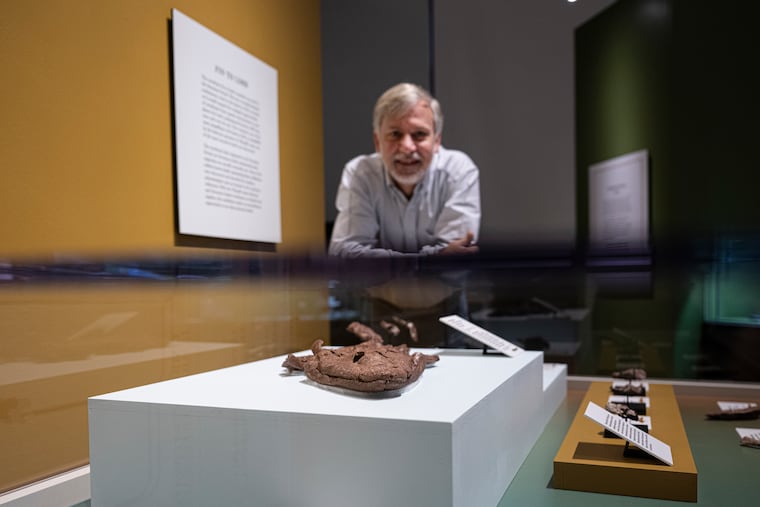The world’s most famous prehistoric fish returns to Philly for one more show
In 2004, Ted Deaschler helped discover Tiktaalik Roseae, a fishlike creature believed to a key link between fish and humans. Tiktaalik returns to the Academy of Natural Sciences for a new exhibit.

By 2004, Ted Daeschler’s research into early prehistoric life led him to the top of the world. Literally. The famed paleontologist at the Academy of Natural Sciences had trekked hundreds of miles north of the Arctic Circle hunting fossils that could shed light on that key evolutionary moment when creatures first wriggled out of the deep and onto land. The fossils of the fishlike beast that Daeschler and fellow scientist Neil Shubin discovered in the tundra shook the scientific world.
Tiktaalik roseae, as the 375-million-year-old carnivore came to be called, plugged a critical gap in the fossil record. With a flat head, neck, sturdy body, and an early version of limbs — picture a 9-foot man-eating salamander — Tiktaalik likely clawed its way out of the primordial stew hundreds of millions of years before dinosaurs arrived.
Scientific journals hailed it as one of the most important paleontological finds in decades. Tiktaalik penetrated pop culture. Political cartoons showed fish storming out of prehistoric seas. Memes joked about the human headaches that could have been avoided if only for Tiktaalik’s wanderlust. And Daeschler, long considered one of the most knowledgeable and enthusiastic promoters of the Devonian period, that time of evolution 350 million years ago, when early life rambled ashore, suddenly found himself exchanging punchlines with Stephen Colbert.
“Explain the origin of all life on earth: Go!” Colbert joked, looking at his watch, when Daeschler appeared as his guest.
The academy’s own Indiana Jones
Now, nearly 20 years after its iconic discovery, Tiktaalik roseae returns to Philadelphia. On loan from its permanent home in the Canadian Museum of Nature, the famous fish fossil stars in a new exhibit at the academy. “Life Onto Land: The Devonian” — opening today and running through September 2024 — explores the significance of the Tiktaalik’s prehistoric heyday, and its impact on the world today. But with so many of Daeschler’s rare finds and specimens on display, the show also serves as a celebration of the paleontologist’s storied career. This month, after more than three decades at the academy, Daeschler will retire from his post as curator and chair of Vertebrate Zoology.
It feels like the academy is losing its own personal Indiana Jones, said Scott Cooper, the president and CEO of the academy.
“He is a generational talent,” Cooper said. “Ted took the academy and put it on the paleontological map.”
While Daeschler’s daring digs and groundbreaking research brought prestige to the museum’s collections, his bounding fascination for all things Devonian proved contagious, Cooper said.
“When I first joined the academy and introduced myself at parties, the immediate response was always: ‘Oh, you must know Ted,’” he said. “That’s what Ted means to the academy.”
Daeschler had established his bona fides well before Tiktaalik — there are only about a dozen scientists in the world who specialize in his field — but toiled in the relative obscurity known to all paleontologists studying anything other than a T-Rex.
“We all know about dinosaurs, and we all know about woolly mammoths,” he said. “But we don’t know about when life came on land.”
Starting out at the academy, he began to dig for Devonian rocks and fossils in the Appalachians, many of them included in the new show.
“We don’t think of this stuff in our backyard,” he said. “But we have world-class fossils from Pennsylvania.”
The big discovery
In the Arctic, he, Shubin, and their team hammered away for three summers. They found Tiktaalik on Ellesmere Island in the Canadian territory of Nunavut (Tiktaalik is an Inuit word for large freshwater fish).
The creature’s clamped jaws showed first, then its flat head and eyes, not unlike an alligator’s.
“That’s exactly what we were looking for,” Daeschler said. “We knew in the field that this is a good one.”
The fossils they brought back to the academy had musculature not found in fish. These creatures would have been able to shift their necks side to side, and up and down. Their flexible fins had primitive versions of wrists and other human bones to prop them up. Daeschler surmises the creature likely headed for land to escape larger predators and find new food sources. It was a modest first step, Daeschler said, believing the beast probably didn’t venture very far.
“Maybe up and over a log,” he said. “Or into the shallows.”
While it’s impossible to know if Tiktaalik is the common ancestor of humans, it’s definitely a distant relative.
“This is where the body plan for all limbed animals came from,” Daeschler said, holding aloft the fossilized Tiktaalik that will be on display in the show.
The buzz eventually cooled, and the talk shows stopped calling. But the significance of his find in the tundra has held up. Daeschler said he’s proud Tiktaalik will be his legacy.
“The idea that you can explore this world, and there’s still things left to discover,” he said. “I just think that’s really nice.”